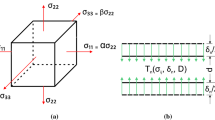Abstract
Anisotropic composite materials have been extensively utilized in mechanical, automotive, aerospace and other engineering areas due to high strength/weight ratio, superb resistance to corrosion and excellent thermos-mechanical properties. As the use of composite materials increases, determination of material properties, mechanical analysis and failure of the structure become essential for the design of composite structure. In particular, the fatigue failure is important to ensure that structures can survive in harsh environmental conditions. The non-homogeneous character of composites induces diverse failure modes of the constituent including fiber fracture, matrix cracking, fiber-matrix interface failure, and delamination, which makes their fatigue behavior very complex in comparison with traditional engineering materials. In this study, based on different failure modes of a unidirectional ply under multiaxial stress states, a progressive damage theory is extended to simulate fatigue failure in composite laminates subjected to cyclic loadings. A cycle-dependent material property degradation model was employed to predict deterioration of the material properties due to arbitrary stress state and ratio. This cycle-dependent material property degradation rule is implemented into user subroutine USDFLD in ABAQUS through which cycle-dependent material degradation states are updated over fatigue loading. The present computational implementation is tested by comparing the experimental fatigue behavior of a 30-degree off-axis specimen with the simulation result obtained by the present implantation. The comparison between the experimental and simulation results demonstrates the successful simulation capability of the present implementation.













Similar content being viewed by others
References
Adam T, Diekson RF, Jones CJ, Reiter H, Harris B (1986) A power law fatigue damage model for fiber-reinforced plastic laminates. Proc Inst Mech Eng 200(C3):155–166
Babaei H, Mirzababaie MT (2016) Modeling and prediction of fatigue life in composite materials by using singular value decomposition method. Proc Inst Mech 234:246–252
Broutman LJ, Sahu SS (1972) A new theory to predict cumulative fatigue damage in fiberglass reinforced plastics. Composite materials, testing and design (second conference). ASTM STP 497:170–188
Burhan I, Kim Ho (2018) S-N curve models for composite materials characterisation: an evaluative review. J Compos Sci 2(3):38
D'Amore A, Grassia L (2019) Comparative study of phenomenological residual strength models for composite materials subjected to fatigue: predictions at constant amplitude (CA) loading. Materials 12(20):3398
Daniel IM, Charewiez A (1986) Fatigue damage mechanisms and residual properties of graphite/epoxy laminates. Eng Fract Mech 25(5/6):793–808
Degrieck J, Van Paepegem W (2001) Fatigue damage modelling of fibre-reinforced composite materials: review. Appl Mech Rev 54(4):279–300
Dong H, Li Z, Wang J, Karihaloo BL (2016) A new fatigue failure theory for multidirectional fibre-reinforced composite laminates with arbitrary stacking sequence. Int J Fatigue. https://doi.org/10.1016/j.ijfatigue.2016.02.012
Gathereole N, Reiter H, Adam T, Harris B (1994) Life Prediction for fatigue of T800/524 carbon fibre composites: 1 constant amplitude loading. Int J Fatigue 16:523–532
Halpi JC, Jerina KL, Johnson TA (1973) Characterization of composites for the purpose of reliability evaluation. Anal Test Methods High Modul Fibers Compos 521:5–64
Hibbitt, Karlsson and Sorensen (1992) ABAQUS: theory manual. Hibbitt, Karlsson & Sorensen, Providence, R.I.
Hwang W, Han KS (1986) Fatigue of composites: fatigue modulus concept and life prediction. J Compos Mater 20:154–165
Kaminski M, Laurin F, Maire JF, Rakotoarisoa C, Hémon E (2015) Fatigue damage modeling of composite structures: the onera viewpoint. AerospaceLab. https://doi.org/10.12762/2015.AL09-06
Kennedy CR, Bradaigh CMO, Leen SB (2013) A multiaxial fatigue damage model for fibre reinforced polymer composites. Compos Struct 106:201–210
Khan A, Venkataraman S, Miller I (2018) Predicting fatigue damage of composites using strength degradation and cumulative damage model. J Compos Sci 2:9
Knight N (2008) Factors influencing progressive failure analysis predictions for laminated composite structures. In: Conference Paper 49th AIAA/ASME/ASCE/AHS/ASC Structures, Structural Dynamics and Materials Conference, Schaumburg, IL, United States.
Pascoe J, Alderliesten R, Benedictus R (2013) Methods for the prediction of fatigue delamination growth in composites and adhesive bonds: a critical review. Eng Fract Mech 112:72–96
Radhakrishnan K (1984) Fatigue and reliability evaluation of unnotched carbon epoxy laminates. J Compos Mater 18:21–31
Reifsnider KL, Stinchcomb WW (1986) A critical-element model of the residual strength and life of fatigue-loaded composite coupons. Composite materials: fatigue and fracture. ASTM STP 907:298–313
Sendeekyj GP (1981) Filling models to composite materials fatigue data. In: Chamis CC (ed) Test methods and design allowable for fibrous composites. ASTM STP 734, pp 245–260
Sevenois RDB, Van Paepegem W (2015) Fatigue damage modeling techniques for textile composites: review and comparison with unidirectional composite modeling techniques. Appl Mech Rev 67(2):020802
Shokrieh MM, Lessard LB (1997) Multiaxial fatigue behavior of unidirectional plies based on uniaxial fatigue experiments. Experimental evaluation. Int J Fatigue 19(3):209–217
Shokrieh MM, Lessard LB (2000a) Progressive fatigue damage modeling of composite materials, Part I: modeling. J Compos Mat 34(13):1056–1080
Shokrieh MM, Lessard LB (2000b) Progressive fatigue damage modeling of composite materials, Part II: material characterization and model verification. J Compos Mat 34(13):1081–1111
Acknowledgements
This work is supported in part by National Aeronautics and Space Administration (NASA) (Grant # 80NSSC17M0050 P00002).
Author information
Authors and Affiliations
Corresponding author
Additional information
Publisher's Note
Springer Nature remains neutral with regard to jurisdictional claims in published maps and institutional affiliations.
Rights and permissions
About this article
Cite this article
Nakai-Chapman, J., Park, Y.H. & Sakai, J. Implementation of progressive failure for fatigue based on cycle-dependent material property degradation model. Multiscale and Multidiscip. Model. Exp. and Des. 4, 41–50 (2021). https://doi.org/10.1007/s41939-020-00080-4
Received:
Accepted:
Published:
Issue Date:
DOI: https://doi.org/10.1007/s41939-020-00080-4




